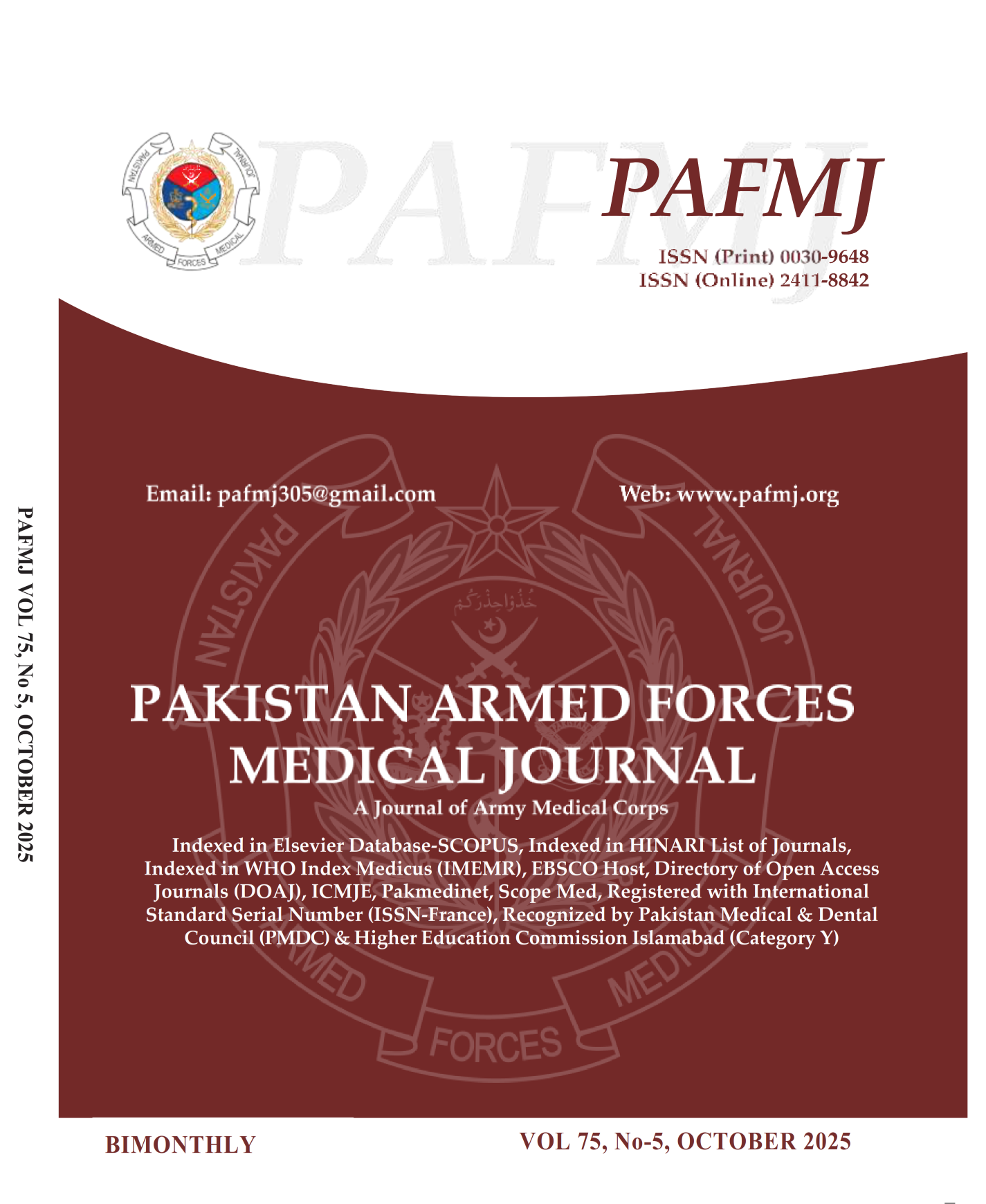Effect of Endoscopic Sinus Surgery on Eustachian Tube Dysfunction in Chronic Rhinosinusitis
DOI:
https://doi.org/10.51253/pafmj.v75i5.8400Keywords:
Chronic Rhinosinusitis, Eustachian Tube Dysfunction Questionnaire, and Endoscopic Sinus SurgeryAbstract
Objective: To assess the effectiveness of endoscopic sinus surgery (ESS) on symptoms of Eustachian Tube Dysfunction (ETD) in adult patients with chronic rhinosinusitis (CRS).
Study Design: Quasi-experimental study
Place and Duration of Study: Department of ENT, Combined Military Hospital, Rawalpindi, Pakistan, from Dec to Jan 2022.
Methodology: The effect of ESS on ETD of 82 patients was evaluated by analyzing retrospective data from the Sino-Nasal Outcome Test (SNOT-22) and Eustachian Tube Dysfunction Questionnaire 7 (ETDQ-7) assessments in adult CRS patients who underwent ESS.
Results: The median (IQR) ETDQ-7 score was 16.0(5), with 50 patients demonstrating clinically significant ETD indications with an ETD-Q score of 15.0 and above. On the other hand, the median (IQR) SNOT-22 score was 45.0(14). The Spearman’s correlation coefficient value of 0.24 (p=0.031) indicated a significant relationship between ETDQ-7 and the total SNOT-22 score.
Conclusion: These results suggest that the E-tube performance of adult CRS patients improves considerably after ESS, and it should be implemented for the management of CRS in adult patients with Eustachian tube dysfunction.
Downloads
References
1. Marino MJ, Ling LC, Yao WC, Luong A, Citardi MJ. Eustachian tube dysfunction symptoms in patients treated in a tertiary rhinology clinic. Int Forum Allergy Rhinol 2017; 7(12): 1135-1139. https://doi:10.1002/alr.22030
2. Van RS, Van de HP, Van RV. Value and discriminative power of the seven-item Eustachian Tube Dysfunction Questionnaire. Laryngoscope 2015; 125(11): 2553-2556.
https://doi:10.1002/lary.25316
3. Kuo CL, Yen YC, Chang WP, Shiao AS. Association Between Middle Ear Cholesteatoma and Chronic Rhinosinusitis. JAMA Otolaryngol Head Neck Surg 2017; 143(8): 757-763.
https://doi:10.1001/jamaoto.2017.0130
4. Kucuksezer UC, Ozdemir C, Akdis M, Akdis CA. Chronic rhinosinusitis: pathogenesis, therapy options, and more. Expert Opin Pharmacother 2018; 19(16): 1805-1815.
https://doi:10.1080/14656566.2018.1527904
5. Kuehnemund M, Lopatin A, Amedee RG, Mann WJ. Endonasal sinus surgery: extended versus limited approach. Am J Rhinol 2002; 16(4): 187-192.
6. Choi KY, Jang S, Seo G, Park SK. Effect of Endoscopic Sinus Surgery on Eustachian Tube Function in Adult Sinusitis Patients: A Prospective Case-Control Study. J Clin Med 2021; 10(20): 4689.
https://doi:10.3390/jcm10204689
7. Taufique ZM, Gordon SA, Rotsides JM, Oliver JR, Liberatore LA. Patient Reported Outcomes of Balloon Dilation for Eustachian Tube Dysfunction Using the SNOT-22 Survey. J Otolaryngol Rhinol 2020; 6: 071.
https://doi.org/10.23937/2572-4193.151007
8. Bayoumy AB, Veugen CCAFM, van der Veen EL, Bok JM, de Ru JA, Thomeer HGXM. Management of tympanic membrane retractions: a systematic review. Eur Arch Otorhinolaryngol 2022; 279(2): 723-737.
https://doi:10.1007/s00405-021-06719-3
9. Llewellyn A, Norman G, Harden M, Coatesworth A, Kimberling D, Schilder A, et al. Interventions for adult Eustachian tube dysfunction: a systematic review. Health Technol Assess 2014; 18(46): 1-180, v-vi.
https://doi:10.3310/hta18460
10. Falkenberg-Jensen B, Jablonski GE, Silvola JT, Kristiansen JF, Hopp E. CT imaging of the Eustachian tube using focal contrast medium administration: a feasibility study in humans. Acta Radiol Open 2020; 9(1): 2058460119900435.
https://doi:10.1177/2058460119900435
11. Stoikes NF, Dutton JM. The effect of endoscopic sinus surgery on symptoms of eustachian tube dysfunction. Am J Rhinol 2005; 19(2): 199-202.
12. Leo G, Piacentini E, Incorvaia C, Consonni D. Sinusitis and Eustachian tube dysfunction in children. Pediatr Allergy Immunol 2007; 18 Suppl 18: 35-39.
https://doi:10.1111/j.1399-3038.2007.00631.x
13. Tangbumrungtham N, Patel V, Thamboo A, Patel Z, Nayak J, Ma Y, et al. The prevalence of Eustachian tube dysfunction symptoms in patients with chronic rhinosinusitis. Int Forum Allergy Rhinol 2018; 8(5): 620-623.
https://doi:10.1002/alr.22056
14. Marino M, Ling L, Yao W, Luong A, Citardi M. Eustachian tube dysfunction symptoms in patients treated in a tertiary rhinology clinic. Int Forum Allergy Rhinol 2017; 7(12): 1135-1139. https://doi:10.1002/alr.22030
15. Bowles PFD, Agrawal S, Salam MA. Eustachian Tube dysfunction in chronic rhinosinusitis: pre and post-operative results following endoscopic sinus surgery, a prospective study. Rhinology 2019; 57(1): 73-77.
https://doi:10.4193/Rhin18.208
16. Higgins TS, Cappello ZJ, Wu AW, Ting JY, Sindwani R. Predictors of eustachian tube dysfunction improvement and normalization after endoscopic sinus surgery. Laryngoscope 2020; 130(12): E721-E726. https://doi:10.1002/lary.28416
17. Chang MT, Hosseini DK, Song SH, Nayak JV, Patel ZM, Lee JY, et al. The Effect of Endoscopic Sinus Surgery on Eustachian Tube Dysfunction Symptoms. Otolaryngol Head Neck Surg 2020; 163(3): 603-610. https://doi: 10.1177/0194599820917396
18. Chen X, Dang H, Chen Q, Chen Z, Ma Y, Liu X, et al. Endoscopic sinus surgery improves Eustachian tube function in patients with chronic rhinosinusitis: a multicenter prospective study. Rhinology 2021; 59(6): 560-566.
https://doi:10.4193/Rhin21.209
19. DeConde AS, Bodner TE, Mace JC, Smith TL. Response shift in quality of life after endoscopic sinus surgery for chronic rhinosinusitis. JAMA Otolaryngol Head Neck Surg 2014; 140(8): 712-719. https://doi:10.1001/jamaoto.2014.1045
20. McCoul ED, Anand VK, Christos PJ. Validating the clinical assessment of eustachian tube dysfunction: The Eustachian Tube Dysfunction Questionnaire (ETDQ-7). Laryngoscope 2012; 122(5): 1137-1141. https://doi:10.1002/lary.23223
21. El-Badry, A. F., Saad, A. E. A. K., El-Din, M. A. S., El-Shehally, A. A., Mahmoud, A. M., & Besar, O. F. (2018). Tympanometric changes before and after treatment with functional endoscopic sinus surgery in cases of chronic sinusitis. Menoufia Medical Journal, 31(4), 1270.
22. Lam K, Schleimer R, Kern RC. The Etiology and Pathogenesis of Chronic Rhinosinusitis: a Review of Current Hypotheses. Curr Allergy Asthma Rep 2015; 15(7): 41.
https://doi:10.1007/s11882-015-0540-2
Downloads
Published
Issue
Section
License
Copyright (c) 2025 Imran Yaseen, Abdul Hakim, Kamran Zamurrad Malik, Ausaf Ahmad Shah, Faisal Manzoor, Shahzad Hanif

This work is licensed under a Creative Commons Attribution-NonCommercial 4.0 International License.















